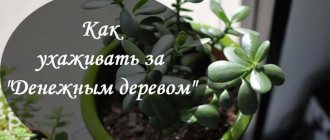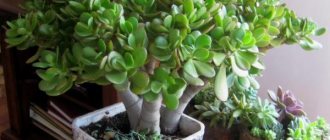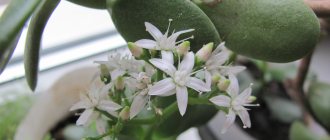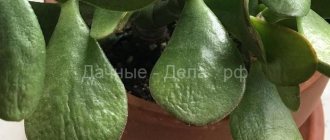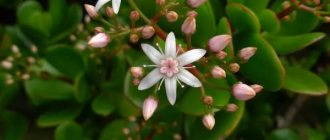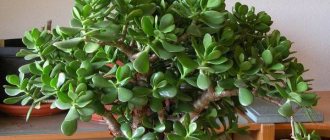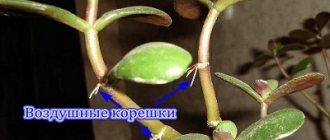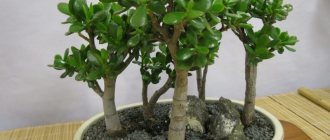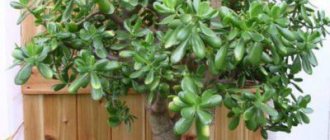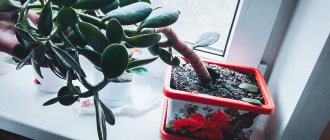Conditions for keeping a money tree at home
Crassula is an unpretentious plant. It easily tolerates lack of moisture and open sunlight. One of its names - Crassula - indicates the ability to accumulate moisture in thick and fleshy leaves. In the absence of watering, Crassula can survive a dry period using its own reserves, consuming water from the foliage.
The extensive Tolstyankov genus includes more than 300 species. Among them are small plants (several centimeters high) and giant ones - up to several meters tall.
This is how Crassula grows with proper care
Table: necessary conditions for the development of Crassula
| Criterion | Spring-summer period | Autumn-winter period |
| Lighting | The money tree prefers a well-lit southern, eastern or southeastern window sill | During the dormant period, from November to March, the pot with Crassula should be placed in a less lit place, for example, on a northern windowsill |
| Air temperature | The ideal temperature range is from 20 to 30 °C. The plant tolerates higher temperatures quite well, but then it requires shading. | The ideal temperature range is from 10 to 16 °C. Critical indicator: -5 degrees |
| Air humidity | After the midday heat, you can spray the leaves to refresh the plant. | Periodically (at least once a week) wipe the leaves from dust |
| Watering | Liberally once or twice a week | Once to three times a month |
The flower signals a lack of moisture with soft leaves. The water should be lukewarm or at room temperature; the best time for watering is in the evening.
Important to remember:
- For proper formation of the bush, the money tree should not be placed close to a window or wall. To ensure that the crown has a symmetrical shape, the fat plant is rotated around its axis from time to time, then the lighting will be evenly distributed to all sides of the plant;
- air humidity is not important for Crassula (the plant is native to the southern regions);
- Crassula copes with a lack of water better than with its excess.
Crassulas have been grown in indoor floriculture for more than three hundred years, since they were brought to Europe by sailors from the African continent.
A healthy money tree needs fertilization. Often this is not required; it is enough to feed the plant once a month with mineral mixtures for succulents.
Video: mistakes when caring for a money tree
Crown modeling
The money tree has an interesting structure, which allows the owner to model its crown to his taste. If you do not control the growth of branches, the tree can become lopsided, stretch out, and acquire an ugly appearance. Forming a crown is not a difficult task: it is enough to remove an unnecessary shoot in time or, conversely, stimulate the growth of an additional branch. To create a new branch, the two apical leaves are pinched. Soon additional stems will appear in this place.
The crown of the money tree can be shaped as you wish
There is no need to rush to remove excess leaves from the trunk of the money tree. As the crown grows, they will disappear on their own, leaving the trunk with a natural appearance.
Video: correct formation of the Crassula crown
After care
In order for a planted money tree to take root smoothly and not get sick, it needs to be properly cared for at home, because replanting is always a serious stress for the plant.
Illumination and temperature conditions
Enhanced lighting is the key to active growth, health and beauty of a green tree. The location of the pot must be chosen in the south, southeast or southwest direction, or on a spacious windowsill next to them.
The color of “money” leaves directly depends on the light intensity.
Due to lack of lighting, variegated and flowering varieties may lose the bright color of their leaves and not bloom. In order for the crown to form evenly, it must be regularly turned towards the light source from different sides. Every summer it is recommended to take the fat plants outside. Choose a well-lit but not windy place - where they will grow well, and some will bloom.
Watering rules and humidity
During the summer, the money tree should be watered deeply every 2-3 weeks. Water young plants more often, every week, especially in high temperatures. During this period, the substrate should dry out in the pot by at least 2–3 cm.
In the fall, water the Crassula every 3-4 weeks. Please note that the top coat will dry very quickly, especially on a sunny window sill through glass, but this is a deceptive effect. Check a little deeper - the soil around the roots is probably still damp. Next time, water when the substrate in the pot is 4 cm dry.
If the soil does not dry out for a long time between waterings, it means that it was chosen incorrectly or the pot was too large and the problem lies there.
In winter, if the fat plant is in a cool room “on vacation” (from November to February), watering should be kept to a minimum. Just make sure that the soil in the pot does not dry out completely. The leaves serve as a signal for watering - they become soft.
Water for irrigation should be used one of the following:
- settled;
- filtered;
- boiled at room temperature or slightly higher.
Indoor humidity does not greatly affect the lifespan of the Money Tree. Its stems and leaves accumulate water and consume it during unfavorable dry periods, for example, during the heating season.
If the room is often ventilated, the tree does well in a city apartment. If for some reason the fat plant ends up in a humid microclimate, then watering should be kept to a minimum. And this flower does not need to be sprayed, as this will worsen the appearance of the leaves and even lead to their rotting.
After watering, excess water must be drained from the pan.
At the same time, to keep the leaves clean and dense, they should be wiped with a damp sponge or rag. Clean leaves are better saturated with oxygen. If the size of the plant allows, you can wash the leaves in the bathroom using a warm shower. You just need to make sure that there is no water on the substrate; it is best to cover the pot with plastic wrap.
Boarding and transfer times
The most favorable time for planting or replanting indoor plants is considered to be early spring, when a new life cycle begins, the plant is ready for renewal and tolerates a change of residence well. The money tree is no exception in this sense.
Crassula also copes well with autumn replanting, although it is undesirable. A good reason for replanting in the fall is plant disease or the appearance of pests. To save the plant, replanting is recommended at any time of the year, even in winter.
How often to replant Crassula
The fat woman does not approve of frequent transplants; this is extremely stressful for her. A young plant (up to two or three years old) should be transplanted into a new pot once a year. An adult tree grows more slowly, so it is enough to provide it with a larger pot once every three to four years.
Why might it be needed?
Because the money tree is a slow-growing succulent plant, it does not require frequent replanting.
But in order to maintain proper decorativeness, and therefore preserve the “magical” properties of the plant, you will have to move it to a new pot from time to time. The money tree is transplanted in the following situations:
- The soil substrate has become depleted. And there are very few useful minerals left. In addition, due to the systematic application of chemical fertilizers, the soil gradually becomes salty.
- The fat plant has grown out of its planting pot. And he became too small for her. Tree roots came out of the drainage holes.
- There are clear signs of rot infection. Or harmful insects that cause damage to the root system. Due to excessive moisture in the substrate, the roots also rot and decompose.
- A new plant was purchased or given as a gift. And it was initially placed in a pot with soil mixture. In this case, the tree is isolated for 2-3 weeks before relocation.
What kind of soil and pot are needed?
The money tree is unpretentious to the composition of the soil and the size of the pot. But he still has his preferences.
Suitable soil
Even a novice gardener can make good soil for a money tree. To prepare your own substrate you will need:
- fresh humus;
- calcined sand;
- leaf soil;
- turf land.
The first three components are taken in equal proportions. But three times more turf land will be needed. The soil should be loose, well permeable to water and air. It is better to maintain soil acidity levels at a neutral value, somewhere in the range of pH 6.5–7.0.
If you don’t want to bother preparing the soil yourself, you can use a purchased mixture. Any universal soil is suitable for a money tree. Ideally, a special substrate for succulents. It is advisable to add sand to the universal mixture (in a ratio of one to four).
Crassula requires good drainage. For young plants, a two-centimeter layer of broken brick, river pebbles or expanded clay is sufficient; for more powerful specimens, the drainage layer increases to 5–10 cm. The top layer of soil must be covered with mulch. It will prevent rapid drying out and give a decorative look to the pot. For this purpose, you can use pebbles, crushed stone, tree bark and chips, nut shells, dried autumn leaves, straw, and processed glass.
Selecting the shape and size of a new pot
The root system of the money tree is located close to the surface of the earth. That is why you need to select wide and shallow pots for it. The diameter of the dishes is determined by the diameter of the crown: the dishes should be slightly wider than the crown. This is necessary for the stability of the plant so that it does not inadvertently turn over.
Shallow, stable containers are ideal containers for Crassula
To highlight the beauty of Crassula, it is better to take a ceramic pot. You can, of course, plant the crassula in an ordinary plastic vessel, but the plant will lose a lot in aesthetic perception. Brown or terracotta-colored dishes go well with the fleshy leaves of the money tree. Feng Shui teachings recommend decorating a pot with coins to attract cash flow. Coins can also be placed in the drainage layer.
Soil for the plant
The money tree prefers loose, not too fertile soil with a neutral or alkaline reaction. A store-bought mixture intended for succulents and cacti is suitable for the plant. Crassula takes root well in specialized soil for palm trees. An unpretentious plant grows and develops in a universal mixture. But such soil must be diluted with sand in a ratio of 1:4.
To make your own substrate, mix the following ingredients:
- part of the turf soil;
- 3 parts leaf soil;
- part of the sand.
Before transplanting a tree into such a substrate, be sure to disinfect the mixture. To do this, moisten the soil with water and spread it in a 5-centimeter layer on a baking sheet. Cover the substrate with foil and heat the substrate for 40–60 minutes at 80 °C. Wait until the soil cools down after disinfection. And add 3-4 tablespoons of wood ash to it.
Methods of propagating a money tree: what exactly to plant
An unpretentious money tree can be propagated in three ways:
- propagation by cuttings;
- leaf rooting;
- sowing with seeds (very rarely used).
The simplest method is cuttings. 8–10 cm shoot tips are suitable for this purpose. The cut of the branch is dried for two days, after which the cutting can be rooted. There are two ways:
- rooting in the substrate;
- obtaining roots in water.
Rooting cuttings in the ground
The cut of the cutting must be treated with crushed coal. You need to take a small pot, but such that the money tree cuttings can live in it at least until spring. For rooting, you will need a light mixture of river sand and garden soil.
Greenhouse conditions are favorable for rooting of Crassula cuttings
Place the shoot in a depression (made, for example, with a pencil), sprinkle it with earth, water it and cover it with film or a plastic cup. You can water the plant without removing the cup. The creation of a greenhouse effect has a beneficial effect on the rooting of the shoot. As soon as a new leaf appears on the cutting, you can remove the cover - the money tree has taken root and started growing.
Growing roots in water
This path is even simpler. On a cut money tree branch, the lower leaves are removed, leaving a couple or two. The cutting is placed vertically in a glass half filled with water with the drug Kornevin added to stimulate root growth. Place the container in a shaded place for two to three weeks. Usually during this time the roots appear - the plant is ready to be planted in the ground.
The cuttings of the Crassula are placed in a glass of water until roots appear.
Growing a new plant from one leaf
Growing a money tree from a single leaf is very similar to rooting a cutting. The cut of the leaf must also be dried and then placed in loose soil. To prevent the leaf from falling, it will need supports made of matches or toothpicks. Creating greenhouse conditions and regular moistening promote leaf rooting. The opportunity to grow a money tree from a single leaf is quite real and achievable.
You can grow a money tree from one leaf
Sow Crassula seeds
Seeds are sown in low containers filled with a mixture of sand and leaf soil, and covered with film or glass to maintain high humidity. To prevent blackleg, the soil is spilled with a solution of Fitosporin.
When is it better to do this, on what days, is it possible in spring and winter?
Since Crassula is most likely in a shipping pot after purchase, the first transplant should be done 15–20 days after purchase. Before transplanting a purchased money tree, it must be given time to adapt to its new place of residence.
The most successful season for transplantation is spring. During this period, Crassula shoots begin to grow intensively, the Crassula actively develops and tolerates changes in living conditions more easily.
If necessary, transplantation in summer is allowed. In this case, immediately after the procedure, you cannot place the flower in direct sunlight. Autumn and winter are rest times for the money tree; it is not recommended to disturb it. The exception is unscheduled transplantation. It may be needed when the plant is sick. If Crassula has stopped growing, is losing leaves, and looks weakened, you should not wait for spring. You can transplant at any time of the year. Poor health is most often caused by waterlogging or the appearance of pests on the root system.
Step-by-step instructions for planting and transplanting Crassula
- We prepare the soil ourselves (as described above) or buy a suitable mixture.
- Take a pot of the required size (how to determine the size is described above).
- Place a layer of drainage at least two centimeters thick at the bottom of the pot.
- Add soil so that the soil fills a fourth of the container.
- Place the plant in the pot, trying to place it in the middle. If a massive money tree is being transplanted, then the transshipment method should be used: carefully remove the plant from the pot by the trunk with one hand, and lightly shake off the soil from the roots. It is necessary to additionally wash or treat the root system only in case of disease or rotting of the roots.
- Add soil mixture, covering the roots. There is no need to compact it.
- Water generously with warm water. After the first watering, it will become clear whether more soil needs to be added.
- Add the required amount of soil and sprinkle with melba on top.
- We place the Crassula in the shade for a week or two so that the still fragile tree does not get sunburn.
Video: replanting a money tree
Step-by-step instructions from pot to pot
Before transplanting the money tree, prepare the substrate. Pour the soil into a container and bake in the oven at a temperature of at least 80 °C. It is important not to exceed this temperature threshold so as not to destroy beneficial microelements.
If you plan to trim the roots, use scissors and pruners cleaned in an activated carbon solution (300 ml tablet of water).
Step-by-step algorithm for transplanting large adult plants:
- Prepare a new pot for planting. Scald it with boiling water (if it is clay). Then sterilize in a dark red solution of potassium permanganate (10–15 minutes).
- Be sure to place a layer of drainage material at the bottom of the pot (about 1/6 the height of the bowl). Then fill the container a quarter full with the prepared soil mixture.
- Gently grasp the trunk and remove the plant to be repotted from its previous pot. It must be remembered that the branches of Crassula are very fragile; if you are not careful, the leaves will fall off.
- If the plant looks completely healthy, then it is best to transfer it, if possible without disturbing the integrity of the earthen clod. If there are signs of rot or insect damage, cut away any affected areas with a sharp, sterilized instrument back to healthy tissue. To dust the cut parts, use finely ground charcoal, or you can burn them with regular green paint. To control pests, soak the roots in an insecticide solution for 5-10 minutes.
- Having dug a small hole in the poured layer of soil, place the extracted Crassula in the middle of the new pot. The root collar should remain in the same position.
- Fill all voids with soil and lightly press with your hands. Leave the rudiments of aerial roots at the base of the bush outside and do not cover them with soil. If necessary, if the tree in the pot is unstable, install a support and tie the trunk to it. When complete strengthening occurs, it can be removed.
- Water the soil thoroughly. If the soil settles a lot, add some substrate to the required level.
- Leave the tree in a shady area.
Parts accidentally broken during transplantation can be rooted and propagated. To do this, place them in water or immediately put them in the ground.
Video instructions for transplantation:
For the Crassula shoot
In order to plant a fat plant, shoots with at least two leaves are needed.
Cut off the cutting and let it dry for a few days. After this, lower it into a glass of water with previously added Kornevin. Leave the plant in this state until roots appear. Plant the germinated cuttings in a pot with prepared drainage according to the following scheme:
- The pots are filled a quarter full with soil.
- The process is placed in the middle.
- As a result, the cutting is watered, planted in a pot without roots, but covered with film to create a greenhouse effect.
Planting
The plant can be transplanted from a common pot after it has grown to 10–15 cm. When following the transshipment method, be careful because the stems and fleshy leaves are relatively fragile and can be damaged quite easily.
Features when planting plants:
- you need to do everything with double care so that when removing one plant you do not damage the neighboring one;
- watch the roots, you might inadvertently grab shoots from another tree;
- The root collar must be kept above the soil surface, otherwise the risk will increase that the plant will not take root.
Possible landing options
Planting a money tree in a separate pot is just one of the possible options. Crassula grows well in a florarium and in a “garden in a bowl.”
Money tree in a home florarium
To plant a money tree in a florarium, you will need a special earthen mixture for succulents and charcoal. Being in a confined space provokes rotting of the roots, and coal allows you to disinfect decaying organic matter.
Crassula looks great in a florarium
Succulents in a florarium should be watered sparingly. Crassula does not like excess moisture, and in a sealed container there will be nowhere for water to evaporate.
Important: do not forget to open the closing florarium for fresh air.
How can Crassula be placed in a “garden in a bowl”
Hardy crassulas are the best option when creating a miniature garden from living plants. This species has about three hundred plants. Many have leaves that are original in color and shape, which give unusual combinations. Having prepared everything, as with the usual planting of a money tree in a pot, begin to plant several types of succulents in a flat container. Such a miniature composition can be moved from place to place and requires minimal maintenance. A “garden in a bowl” made from several stems of a money tree can be placed not only on the windowsill, but also on a coffee table, shelf or computer desk.
Crassula is used very often in such compositions.
Choosing a pot
When choosing a container, pay attention to the following parameters:
- material;
- form;
- size.
For money trees, choose clay pots. In this breathable material, Crassula receives more air, which is why it develops better. In addition, moisture does not stagnate in clay containers. Therefore, the roots of the fat plant rot in them less often than in plastic ones.
Crassula has superficial roots. Therefore, wide but shallow pots are preferred for it. Choose containers whose height does not exceed their diameter. Otherwise, moisture will accumulate at the bottom, which will lead to rotting and fungal diseases of the crop.
The size of the pot for Crassula should be 1-1.5 cm larger than the roots. If you plant Crassula in a spacious container, the undeveloped soil will turn sour. And this will lead to illness and even the death of the culture. But a pot that is too tight will not work. After all, in such a container the plant stops its growth and development, which negatively affects its decorative effect.
If you don’t know how to choose the right size pot for the first transplant, then look at the crown of the tree. Its width corresponds to the volume of the roots. Therefore, adjust the dimensions of the container to this parameter. In the future, when replanting, use pots whose diameter is 1–2 cm larger than the previous ones.
Before transplanting the money tree into a new container, soak the container in warm water for a day. Then the material will absorb enough moisture and will not dry out the soil after the event.
If you are transplanting Crassula into a pot that has already been used before, be sure to disinfect the container. To do this, wash the vessel with soap, preferably laundry soap, and rinse under running water. Finally, pour boiling water over the inner surface. So, you will destroy all fungi and bacteria that could live on the walls of the dishes.
Typical mistakes when planting Crassula, ways to correct it
Sometimes a florist, relying on the unpretentiousness of the money tree, does not provide it with proper care. Mistakes made when planting Crassula can lead to disastrous results.
A flower is planted in a disproportionate pot
A money tree planted in a disproportionate pot does not grow well. A container that is too deep leads to stretching of the main root and trunk of the plant. The next time you transplant, you need to pinch the elongated root. Gradually, Crassula will restore its beautiful appearance. A pot that is too small can cause the plant to fall, as it will not be able to support the overgrown crown.
Overwatering
The fat woman lives according to the principle: drought is better than flood. Excessive watering leads to rotting of the root system. Watering the money tree is required as the surface of the earth dries out. Sometimes, instead of watering, you can spray the plant or wipe the leaves with a damp cloth. If the “flood” does occur, then the fat woman needs the onset of the “dry season”. If it doesn’t help, we urgently replant the plant.
Proper care of Crassula after replanting
Transplantation is one of the basics of caring for a money tree. An incorrectly transplanted tree may fall on its side or wither. After the fat plant has been transplanted, you need to follow the basic rules and recommendations for growing the plant:
- Initially, you should remove the pot with the plant to a shaded place where the burning rays of the sun will not penetrate. The plant should be kept in this place for a month after transplantation. After a month, the plant can be placed on the windowsill without fear of sunlight.
- Watering a transplanted succulent is not often necessary.
- The coin tree should not be sprayed, as high moisture must be avoided. If dusty, wipe the wide leaves with a soft, slightly damp cloth.
- Periodically it is necessary to loosen the soil to provide the roots with oxygen.
- There is no need to feed Crassula in the next two to three months.
- After transplantation, monitor the temperature. Drafts should not be allowed, otherwise the plant may get sick. The pot with crassula should not be kept close to heating devices or radiators to prevent the flower from drying out.
Crassula flowering
The money tree rarely blooms indoors. In nature, Crassula flowering begins after the end of the dry season and the arrival of heavy rains. To obtain a similar effect, it is necessary to recreate similar conditions in the room where the fat woman lives. To do this, it is necessary to keep the money tree in a cool place during the winter months on a meager diet, watering extremely rarely. As spring approaches, increase watering and provide access to sunlight. Perhaps Crassula will bloom with small white flowers. However, it should be borne in mind that flowers appear only in the tenth year of the plant’s life.
The money tree rarely pleases with blossoms
Video: how to make a money tree bloom
Reproduction methods
To become the owner of a wonderful flower, when someone you know has it, it is enough to propagate it. The leaves and cuttings of the money tree take root well, and if desired, the plant can be obtained from seeds. The last method is designed for the most patient, so it is rarely used.
Rooting cuttings
Cuttings are the fastest and easiest way to get several young plants from the mother specimen. The tops 8-10 cm long are cut off from several healthy shoots, and the sections are sprinkled with activated carbon powder. An earthen mixture consisting of equal parts of garden soil and sand is poured into a small pot, a hole is made with a pencil and a cutting is inserted into it. The remaining sections are planted in the same way.
Cover the top with a transparent plastic cup or plastic wrap. Water regularly. A sign that the fat plant has taken root is a formed leaf. When it starts to grow, the shelter is removed.
You can also germinate cuttings in water, and this method is easier than the previous one. 1 or 2 pairs of upper leaves are left on the cuttings, the rest are removed. The shoot is placed vertically in a glass of water. It is useful to add a little root formation stimulator so that the roots grow more actively.
For 15 days, place the glass in a semi-dark place, not forgetting to add water. By the end of this time or earlier, root buds appear. When the roots reach a length of 2-3 cm, the Crassula can be planted in a pot.
Growing from a leaf
To get a full-fledged plant, one leaf is enough. There are usually no problems with rooting Crassula, so this method will help out when it is not possible to buy, ask, or otherwise obtain a cutting. If the sheet had to be separated inaccurately, you need to make an even cut. After this, the plate should be left for 2 days for the wound to dry out.
The cut area is sprinkled with crushed activated carbon and the leaf petiole is inserted into the ground. On both sides, make supports from toothpicks or simple sticks so that the sheet does not fall. Cover the pot with plastic wrap to keep the air inside moist. Under such conditions, the roots will begin to grow in 10-15 days. Once every 3-4 days, the polyethylene is removed for 2-3 hours to allow the plant to ventilate. If the petiole begins to rot, you need to take it out, trim it to healthy tissue, dry it and plant it again. The frequency of watering should be reduced, since planting material usually deteriorates due to waterlogging.
The young plant needs to be replanted into another pot next year. Then the transshipment is repeated annually until the Crassula is 3 or 4 years old.
Seed method
Growing from seeds is complicated due to the fact that the fat plant blooms very rarely, and it is quite difficult to collect seed material from it. Flower growers use this method when they need to propagate a new species. Seeds germinate quickly, in about 10-15 days. First, they need to be washed, dried and sown in a mixture of turf soil and sand. Before or after sowing, it is recommended to water the soil with a solution of “Fitosporin” to avoid infection with the “black leg”.
Until sprouts appear, the shelter is removed daily for 1-1.5 hours so that the air does not stagnate. When it is clear that most of the seeds have sprouted, the film or glass is removed for good. There is no need to thin out; it is better to initially provide enough space for each seedling. When young plants form 2-3 pairs of leaves, they are planted in separate pots.
In addition to pots, bowls are suitable for transplanting Crassula. They allow you to turn your indoor garden into a miniature copy of an ordinary one. You can create such a masterpiece at home in 1 day. First, select a wide but shallow bowl. Then several crassulas are selected, differing in height, color and leaf shape. Plant them all in one container, but not too densely. The result should be an imitation of a garden with trees. The good thing about a bowl as a vessel is that it is easy to move from one place to another.
Correctly following the step-by-step recommendations and taking care of the flower is the key to success. With proper care, the fat plant delights with its unusual appearance for several years, and after that it can be rejuvenated by trimming the crown. Such a flower really brings happiness to the house, because just looking at it improves your mood.
At what time to replant?
Autumn, winter and early spring are the best period for such a transplant. In mid-spring, the plant already begins a period of active growth and this procedure will harm the flower.
The next pot should be approximately 5 cm larger than the previous one.
An adult plant is replanted every 4-5 years.
If a flower is in the same container for more than 4 years without changing the soil, then its soil becomes poorer. Over time, beneficial minerals are washed out of the soil.
Such specimens are transplanted using the transshipment method.
- To begin with, prepare a container 5 cm larger than the previous one. In a container that is too large, the soil will remain wet longer and this will lead to rotting of the roots.
- A layer of drainage is laid on the bottom. And fill one third with fresh soil. For practicality, a piece of broken ceramic is placed at the bottom. It will serve as a barrier to prevent the soil from being washed out through the drainage holes.
- Carefully, trying not to damage the leaves, take the plant by the trunk, along with the earthen lump, deepen it in the center into a new container and add fresh soil.
- The soil needs to be pressed down well and watered. After excess water has drained onto the tray, the pot is placed in a place where direct rays of the sun do not reach.
On a note!
When transplanting an adult plant, it is necessary to consider the condition of the root system. Remove all old, damaged shoots and sprinkle cut areas with crushed activated carbon.
Reasons for replanting a plant
Reasons for transplanting a money tree may include:
- Insufficient volume of soil for the growing root system of the plant;
- Soil depletion;
- Diseases of the root system.
In young plants, the root system grows quite quickly. Soon she feels cramped in the old potty. Sometimes the roots may even emerge through drainage holes or through the surface of the soil. If you take such a tree out of the pot, you will see that the roots are tightly entwined with an earthen ball. In this case, it is necessary to transplant into a larger container so that there is room for the growth and development of roots.
The growth of the root system at a young age occurs intensively, so the plant must be replanted often. With age, the rate of root growth slows down. The tree will no longer be cramped in the pot. But replanting is still necessary, since the soil in the pot is gradually depleted and no longer provides the plant with sufficient nutrition.
Succulents, which include the money tree, do not require very fertile soil. They grow well in depleted soils. Therefore, it is not necessary to replant an adult money tree every year. But this procedure must be carried out, otherwise the plant gradually slows down its growth, sheds its leaves and loses its decorative effect.
In case of diseases of the root system, the money tree requires an emergency transplant. In this case, the roots are inspected to detect and remove diseased parts. If during a normal transplant it is recommended to replant the plant, then during an emergency transplant the soil is changed completely.
When and how often to replant a plant?
You can choose the right time for a planned transplant based on both the needs of the plant itself and the recommendations of the lunar calendar. It is better to do this in spring or summer, so that in July-August the tree adapts and gets used to new conditions, because in the fall it will begin to prepare for dormancy. The table of favorable days of the lunar calendar takes into account the phases of the moon and the seasonal biorhythms of plants and will help you choose which day is best to replant. The period of the waxing moon is important, and the preferred day of the week is Wednesday.
Transplanting a money tree: crown formation (video)
When making your own planting soil, it is recommended to mix one part of turf soil, one part of medium-grained sand and about three parts of good leaf soil, with the addition of a small amount of clay and wood ash, which will balance the acidity of the planting substrate to levels that are comfortable for the fat plant. High-quality drainage is very important when cultivating succulent plants.
Each subsequent transplant of an indoor flower must be done in a large container. A layer of expanded clay should be placed on the bottom of a pre-prepared flower pot. It is best to use a container that is not too deep for growing crassula, which is due to the small volume of the root system and its location in the upper soil layers. When replanting, it is necessary to take into account the massiveness of the above-ground part of the plant, therefore, in order to maintain a sufficiently extensive crown, the indoor plant must be provided with a sufficiently wide and maximally stable flower pot. The best option is to grow in pots made of ceramic or clay.
Scheduled transplant time
Let's consider when you can and should replant a money tree. Typically, a planned transplant of Crassula is carried out in the spring. This is done immediately after wintering, while the tree has not yet begun to grow. As for emergency transplantation due to damage to the roots, it can be done at any time. In this case, you cannot wait until spring; you need to save the plant as soon as possible.
It is recommended to replant young plants every year. Annual replanting will provide the necessary space for the development of the root system and the necessary nutrition for the growth of the entire tree.
Adult fatworts after 3 years are replanted every 3-4 years. This regime is necessary so that the plant receives from the soil nutrients sufficient for its intensive growth. The money tree should not be replanted less than once every 4 years, since lack of nutrition usually affects its appearance.
Secrets of proper landing
Beginning gardeners quite often plant a houseplant on their own using a cutting received from their friends or experienced amateur gardeners. The shoot must be completely healthy and well developed. In order for the money talisman to work, you need to transplant the decorative crop as correctly as possible:
- despite the fact that many flower growers recommend determining the timing of planting and replanting the crassula according to the lunar calendar, the owners of the “money tree” have seen in practice that a plant transplanted in the spring takes root much better and faster;
- it is very important to transplant and plant the plant on the day of the waxing moon, on Wednesday, which will increase the magical properties of the plant;
- At the bottom of the flower pot you need to put eight coins of the same denomination, placing them with the coat of arms facing up;
- During the process of transplanting or planting, you need to read the spell: “You bloom, and I grow in wealth. This is my will, so be it.”
It is recommended to water the decorative crop on Wednesdays, and it is also advisable to hang coins strung on a red thread on the branches of the plant.
